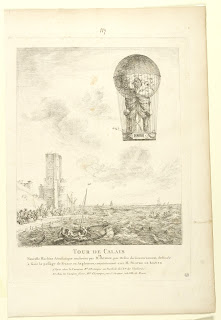The portraits are rather good, and the sitters are identified by the text on the reverse of the paintings, which seems plausible in this case (too often the text on the back promises more than the front can deliver).
The man is Abraham van Susteren, brother to Hendrik, the Bishop of Bruges. He died in 1699. His wife, Joanna Margarita de Berault de Villetart was a noble lady from a minor house who lived until 1733. From the biography of the bishop of Bruges, we learn that his parents were married in 1657, placing this portrait in the 1680s at the earliest, and 1699 at the latest of course.
However, according to the Bossche Encyclopedia (the online encyclopedia of 's Hertogenbosch, famous as the city of Hieronymus Bosch, and the origin of the Van Susteren family), Abraham was the uncle of Hendrik, the son of his elder brother Gisberto. According to this source, Abraham was already born in 1628, and married Anna de Berault de Villeterre in 1667. This would date his (and presumably her) portrait anywhere between 1667 and 1699, but he doesn't look like a man of 60 years or older, so it presumably dates to the late 1660s or to the 1670s, and may well have been painted at the time of the engagement or marriage.
More information about Abraham and Joanna Margarita can be found in an old article in "De Biekorf" from 1969, which confirms the Bossche Encyclopedia information. It adds that he came to Bruges ca. 1665, that the family of Marguerite (aka Anne or Joanna Margarita) de Berault de Villeterre objected to her marrying a commoner (even though he was a rich merchant), that his maternal grandfather died at the famous battle of Leckerbeetje (subject of many paintings by Sebastian Vrancx and others).
I haven't been able to find any information about this portrait of Van Susteren, but while searching I found out that he was responsible for the shipping of Flemish paintings to Spain, where one or two of his sons lived as representatives of his company. He worked together with Antwerp art dealer Matthijs Musson (1598-1675).
For these portraits, I looked at portrait painters active in Bruges in 1667 or a bit later. The only candidates I find from this period who has the skill displayed in these works (skills which would have been common in Antwerp or in some parts of the Northern Netherlands, but not in every city or town) were Jacob Van Oost (1603-1671) and Jacob Van Oost II (1639-1713), father and son, and Jan Baptist Herregouts (1646-1721), who only moved to Bruges in 1677 and became a Master there in 1684, and Hendrik Herregouts, his brother.
Jacob Van Oost the Elder seems a better painter than what we have here (probably the best painter in Bruges in this period, together with the more highly specialized cityscape painter Jan Baptist van Meunincxhove, who had a nice work for sale at Vanderkindere on 29 May). The two Herregouts are probably just too late to be candidates for these
works, and their style doesn't really match the more fleshy, baroque
style of the portraits for sale.
Which leaves us with Jacob Van Oost the Younger. While the portrait of a man, from the Boston Museum, seems at first sight better than the one for sale, it has on closer inspection the same slightly featureless face.
And the Boston work is the best one I could find, most paintings are less richly detailed and closer to the portraits for sale. The RKD lists for example a portrait sold in 1990 in Brussels, a work sold by Hargesheimer in 2016, and one sold at Hampel in 2011.
There are also some portraits of women we can compare with. These include one sold at Hagels in 1994, and a very nice portrait offered in 1984 by Chaucer Fine Arts.
Whether the two portraits really are by Jacob Van Oost II is hard to decide, his known work varies rather wildly in quality. But for anyone interested in more provincial painting in 17th century Flanders for a reasonable price, these two offer a good opportunity.































